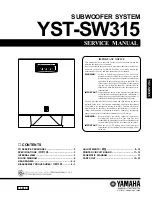
It had long been the practice of stereo buffs to connect
their television to the stereo system. The advantage was the
use of the larger speakers and more powerful amplifier of the
stereo system. Even though the sound was greatly improved,
it was still mono and limited by the broadcast signal.
In the late 1970's and early ‘80's two new home movie formats
became widely available to the public: VCR and laser disc.
At the same time video screen sizes began increasing.
By 1985, both formats had developed into very high quality
audio/video sources. In fact, the sonic performance of some
video formats exceeded audio-only formats. Now, with
theater quality sound available at home, the only element
missing was the "surround sound" presentation found in
movie houses.
Fortunately, "Dolby" and "DTS" encoded material (which
include almost all movies) have the same surround sound
information encoded on home releases as the theater films.
All that is required to retrieve this information is a decoder,
additional speakers, subwoofer(s) and amps to reproduce it.
Home theater is a complex purchase and we recommend
that you consult your local MartinLogan dealer, who is well
versed in this subject.
Each piece of a surround system can be purchased sepa-
rately. Take your time and buy quality. No one has ever
complained that the movie was too real. The following list
and descriptions will only give you a brief outline of the
responsibilities and demands placed on each speaker.
Front Left and Front Right
If these speakers will also be the same two used for your stereo
playback then they should be of very high quality and able to
play loud (over 102 dB) and reproduce bass below 80 Hz.
Center Channel
Many experts believe this to be the most important speaker
in a home theater system, as almost all of the dialogue and a
large portion of the front speaker information is reproduced
by the center channel. It is important that the same manu-
facturer of the front speakers design the center speaker and
that it is recommended for use as a center speaker. This is
not the place to cut corners.
Surround Speakers
We recommend that the surround speakers play down to
70hz. The surround, or effect speakers contain critical infor-
mation. In films, sound effects are vital to the director in
delivering a complete experience and the rapid technical
increase in the discreet capacity of these effects channels has
made their quality vital. This is equally true in music play
back because of the emerging high definition, multi-channel
music only formats. Full range instruments, voices and ambi-
ent queues are being routed to the effects channel. In the
past, some may have suggested that this was the place to
save money by purchasing small inexpensive speakers. If you
choose to do so, be prepared to upgrade in the future.
Subwoofer
With any good surround system you will need one or more
high quality subwoofers (the .1, in a 5.1 channel surround
system). Most movie soundtracks contain large amounts of
bass information as part of the special effects. Good sub-
woofers will provide a foundation for the rest of the system.
16 Home Theater
H
OME
T
HEATER
Figure 18.
Depth Subwoofers as the LFE (effects) channels, MartinLogan
Odyssey speakers as front channels, MartinLogan Theater as the center
channel, MartinLogan Scripts as side surround (effects) channels.
Содержание Depth subwoofer
Страница 1: ...D E P T HTM u s e r s m a n u a l c l s e l e c t r o s t a t i c M A R T I N L O G A N...
Страница 22: ...NOTES 22 Notes...
Страница 23: ...Notes 23...









































